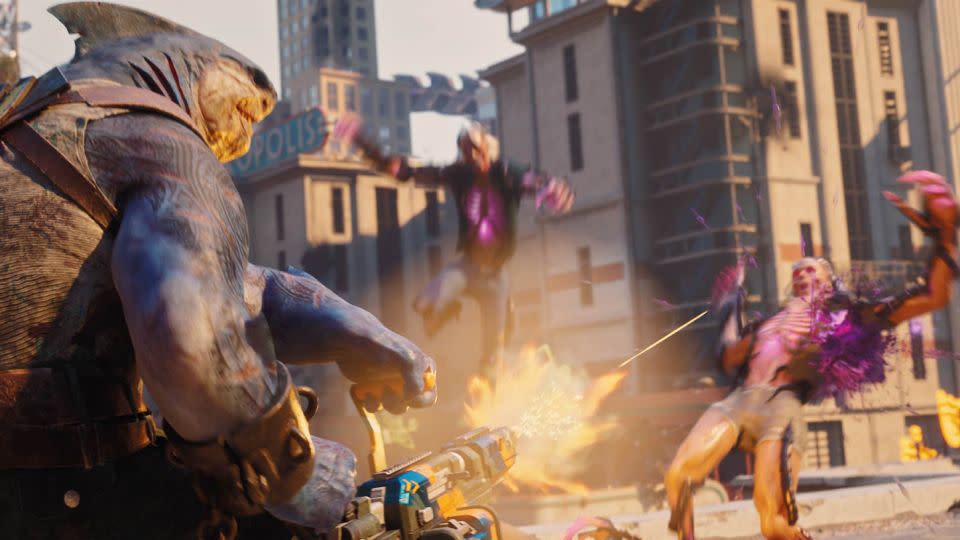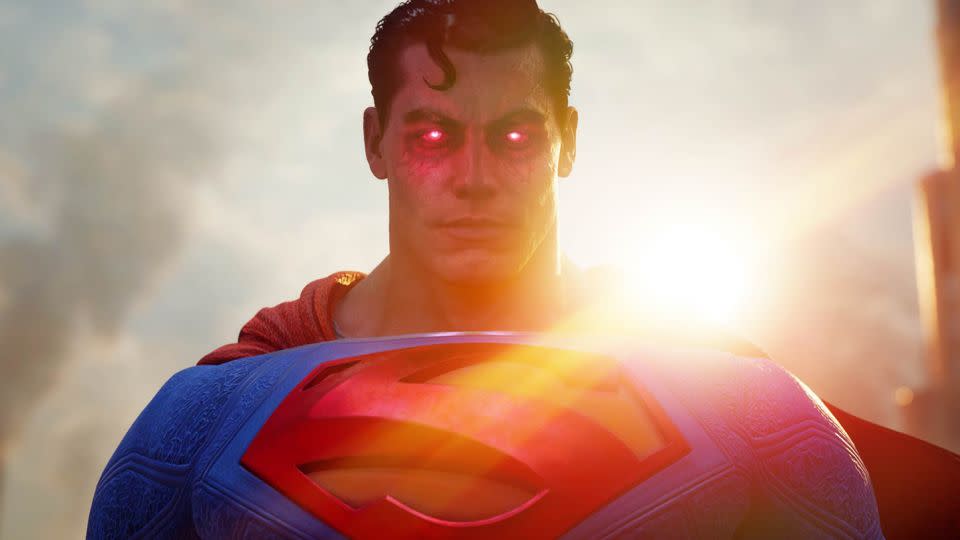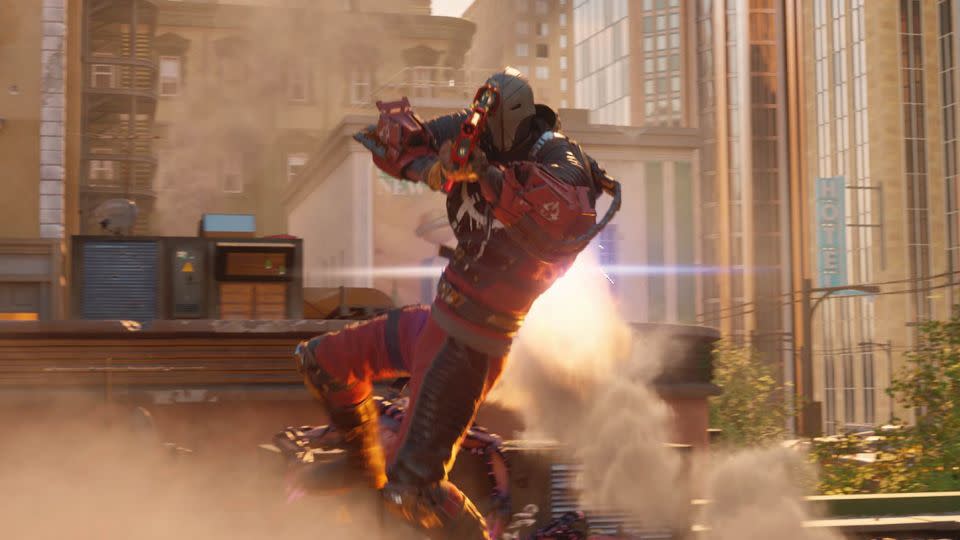Suicide Squad: Kill the Justice League is a fun yet disappointing anti-hero adventure
- Oops!Something went wrong.Please try again later.
Content is created by CNN Underscored’s team of editors who work independently from the CNN newsroom. When you buy through links on our site, CNN and its syndication partners may earn a commission. Learn more

Almost 10 years have passed since developer Rocksteady Studios released the final entry in its beloved Batman Arkham trilogy, and its influence can still be felt in games ranging from Marvel’s Spider-Man to other Warner Bros. properties like Shadow of Mordor and Hogwarts Legacy. The Arkham series’ evolved take on the open world genre inventively blended free-flowing combat, stealth and metroidvania-like level design that encourages exploration. However, the gaming industry has changed significantly since then. Live games-as-a-service titles such as Fortnite and Destiny have become cash cows. Meanwhile, expensive big-budget single-player games are becoming few and far between.
This is what makes Suicide Squad: Kill the Justice League a unique and frequently awkward case study within that conversation. Players are given the choice to play as Captain Boomerang, Deadshot, Harley Quinn or King Shark, all of whom have been forced into a mission that at first glance sounds overwhelmingly impossible. DC supervillain Brainiac has not only invaded Metropolis but brainwashed Superman, Batman, the Green Lantern and the Flash into evil henchmen. Through devious A.R.G.U.S. leader Amanda Waller, Task Force X a.k.a. the Suicide Squad are charged with doing as the game’s title suggests.
For all the ambitiously bold swings the game takes, there are an equal number of issues that hold the open-world loot shooter back from the high pedigree that Rocksteady Studios is known for. The core shooting and traversal mechanics are wisely designed to make combat a blast. It’s made even better by the four-player, cooperative online multiplayer that supports crossplay and cross progression across various gaming platforms.
Nonetheless, the combat scenarios get repetitive and feel more like filler between some fairly fantastic boss battles with various Justice League members. Then there are the live service aspects that won’t sway individuals who have issues with that style of game — especially a full priced one at that. Thankfully, Suicide Squad: Kill the Justice League has enough personality in its style and presentation to cautiously recommend.
Suicide Squad: Kill the Justice League is available now for PS5, Xbox Series X|S and PC. Here are our thoughts after completing the game’s 10-hour campaign alongside the first round of endgame content.
Suicide Squad: Kill the Justice League

Suicide Squad: Kill the Justice League offers fun combat and traversal, an engaging story and great visuals, but it’s held back by repetitive missions and an unsatisfying progression system.
$70 at GameStop
$70 at Best Buy
$69 at Amazon
What we liked about it
Traversal and combat mechanics shine
The core of Suicide Squad: Kill the Justice League is split between getting from point A or B, engaging in various combat scenarios, gaining experience and getting loot. Part of the game’s charm is how notably different each Tasks Force X member plays.

Captain Boomerang, the fastest character, has a Speed Force boomerang that allows him to teleport wherever it’s thrown. Meanwhile, King Shark is the slowest but uses charged jumps for long-range movement and has heavy-hitting melee attacks. Deadshot could be considered the most mobile, thanks to his jetpacks, and Harley Quinn uses Batman’s grappling gun for controls that feel like a new take on the Arkham series. Interestingly enough, there’s a cool-down meter during traversal that does slow down the pace a bit but makes sense during combat. The best way to describe traversal is that it sits between the Arkham games and Marvel’s Spider-Man. When it comes to combat encounters, the pacing feels like a blend of the systems-based tactical shooting Destiny made popular and the mobility of the Crackdown series. There’s an arcade-like feel to combat that has just enough nuance.
Several mechanics correlate to each of the members, starting with the two firearms they can equip, which range from pistols and submachine guns to shotguns and sniper rifles. Taking a bit of inspiration from Gears of War, the game features active reloads that can make the next set of shots more powerful. During combat, Task Force X members take on the various enemy types with both single and area-of-effect attacks alongside grenades. Some of those enemies may require certain tactics that may rely on a particular Suicide Squad member. In what feels like a shooter-based take on Arkham’s counter system, players can even send a counter shot before enemies use certain attacks and gain perks for successfully attacking without getting hit.

By the time players reach the final moments of the main campaign, firefights can sometimes get overwhelmingly frantic in a good way. Outside of “kill all the enemies” missions, there are a handful of variations such as “collect resources from dead enemies,” escorting vehicles and destroying objectives. Players can even commandeer a powerful flying vehicle in later missions. After the first handful of hours, those missions get pretty boring, which we’ll touch on later.
The best missions are the ones that lead up to the fight against the Justice League itself. During those big fights with superheroes turned villains like the Green Lantern and Superman, there’s real variety in how to approach those battles. During single player, some missions and boss fights actually will have a specific Task Force X member receive a boost.
Good audio and visual presentation
Presentation is the most consistent pillar of Suicide Squaid: Kill the Justice League. Visually, this sets a new standard for online-based loot shooters. This game impresses in art direction, technical feats and performance. Then there’s the absolutely phenomenal audio. Voice casting for the heroes, villains and everyone in between is perfect; that includes Kevin Conroy’s final performance as Batman. From combat to cutscenes, the generally awesome sound design helps sell the experience even more.

A big contrast from the darker-styled Arkham series is how colorful and bright the game is. Then there’s the open world of Metropolis itself. Without spoiling anything, all the various districts and locations have a real piece of personality that feels lived in pre-destruction. Having Brainiac’s spaceship overlook the entire world adds to the main villain’s omnipresence. Lighting, shadows, reflections and light destructibility also look great.
Adding personality to the visuals are gorgeous character models and animations. Suicide Squad: Kill the Justice League has some of the best in-engine cutscenes in a live-service game. Rocksteady Studios really pushes Unreal Engine 4 to the max in all the right ways. On all consoles, the game runs on one visual mode and consistently stays locked at 60 frames per second with some occasional dips. PC players can go the extra visual mile with ray-tracing capabilities for ultra-realistic reflections. Having these visual wonders in an online co-op loot shooter at a high frame rate with short load times sets a real performance standard.
Every member of the voice cast of Suicide Squad: Kill the Justice League steps up to the plate. Tara Strong (Harley Quinn), Daniel Lapaine (Captain Boomerang), Bumper Robinson (Deadshot) and Samoa Joe (King Shark) have amazing chemistry among them. They really do sell this unlikely team really well during humorous and dark moments. As Amanda Waller, Debra Wilson proves she is one of the most underrated voice actresses in modern gaming. The former MadTV actress really becomes a commanding force with each encounter and voice transmission in the game. Other standouts include Nolan North as Superman and Conroy, who turns Batman into a truly terrifying homicidal maniac.
Comedic tone and story work well
Though the repetitive mission structure (more on that below) holds back the story, the tonal shifts will remind players of James Gunn’s 2021 film “The Suicide Squad” — and that’s a true compliment. The most important aspect of Suicide Squad: Kill the Justice League is the forced camaraderie between the four playable leads. The interactions between them go a long way toward keeping the story entertaining. Pushing those forward are the excellently produced cutscenes that’ll possibly leave players with their jaws on the floor.
This extends to supporting characters as well. The tense tug-of-war between Task Force X and Waller alongside the rest of A.R.G.U.S. as they attempt the impossible mission is captivating. Watching Wonder Woman push aside the Suicide Squad as nobodies in her doomed fight against former allies hits the right notes between comedy and tragedy.
Individual motivations of the Suicide Squad also come through some of the boss fights. Captain Boomerang’s rivalry with the Flash goes to some dark places by the segment’s finale, and a battle with Batman has Harley Quinn questioning her own self-worth outside of the Joker. Considering Task Force X’s mission is to kill the most powerful metahumans in existence, the setup for how the objective gets done is clever. That includes a whimsical take on the multiverse, which not only introduces variants on different characters but plays into endgame content.
Within the context of the Arkham Universe, Suicide Squad: Kill the Justice League takes a narrative risk that succeeds for the most part. It does a great job of living on its own merit while providing smart callbacks to the original Arkham trilogy through the return of Riddler Challenges and even the introduction of evil Batman himself.
What we didn’t like about it
Repetitive mission structure
As mentioned previously, mission variety revolves around “collect resources from dead enemies,” escorting vehicles, defense and destroying objectives. Some of the side missions may have some variations on win conditions, such as missions where players can only use grenades or ones where enemies may only get hurt with critical shots. But beyond the boss fights against the Justice League, players will have seen all the core combat scenarios halfway through the game. This can lead to the feeling of repetitiveness during the main story that makes the final moments a bit of a chore to get through.

Following the final battle with Brainiac, there are Elseworld missions that serve as the endgame. This involves players going through various multiverse versions of Metropolis that offer higher challenges and more loot. To fully complete the game, players are going to have to essentially kill Brainiac 12 more times. Unless you’re playing with friends who have an equal appreciation of the game, it’s going to feel like busy work.
The progression system is unsatisfying
Adding to the repetitiveness of the missions is the unsatisfying feel of loot grinding. Aside from the two weapons, there is upgraded gear for melee weapons, grenades and shields. Then there are items that come through specific moments in the story. The problem is that players will get the best gear around halfway through. Perhaps the current randomization of loot is possibly broken, but there’s a wonky evolution to gear sets. There’s a real lack of feeling that characters are becoming more powerful in weaponry after a period of time.

Meanwhile, the more system-based character upgrades aren’t really noticeable beyond the incredibly small amount of new attacks that come with leveling up. Most of the upgrades split between firearm, melee and traversal feel like incremental improvements. To be honest, the upgrades feel like a hardcore RPG in the vein of Baldur’s Gate 3 or Cyberpunk 2077 1.0 where it’s more about percentage increase to certain attributes. Based on your current loot and character upgrades, most missions will let you know how likely you are to successfully complete them, but accurate shooting, dodging and countering is good enough to make it past most missions. Like CD Projekt Red did with Cyberpunk 2077, maybe Rocksteady Studios can turn this system around.
Typical live service issues
Suicide Squad: Kill the Justice League is a live service game that looks to offer free content through seasonal updates. New environments, characters, gear and story content are on the way starting in March. Similar to failed games like Anthem and Marvel’s Avengers, the frequency of those updates will likely depend on the actual success of the game. Though Rocksteady promised an offline mode eventually, right now, the game requires an online connection. If the game is considered a failure, will those updates come? Who knows.
Then there are the various currencies that feel convoluted. Credits, Precious Alloys, Coluan Crystals, B-Technology, Intertron and Nth Metal are used to do everything from purchasing new loot to crafting items. When the endgame comes, players are going to have to do missions that earn them Promethium. This currency allows players to access Incursion Missions for accessing the other Brainiac missions. If players want to change character costumes, they have to purchase LuthorCoins with real money. It’s just too much for this sort of game.
Bottom line

It’s understandable how many can see Suicide Squad: Kill the Justice League as a dissappointment. Regardless, the game offers a unique blend of gameplay mechanics and narrative elements that provide real fun. While its traversal and combat mechanics shine brightly in providing a refreshing take on the open-world loot shooter genre, the repetitive mission structure and unsatisfying loot progression hold it back from reaching its full potential.
Nevertheless, the game’s audio/visual presentation is top-notch, setting a new standard for online-based shooters while its comedic tone and story execution provide moments of genuine entertainment. Despite its flaws and the uncertainties surrounding its live service model, Suicide Squad: Kill the Justice League manages to carve out its own place in the triple-A gaming space.
Note: The prices above reflect the retailers' listed price at the time of publication.
For more CNN news and newsletters create an account at CNN.com

